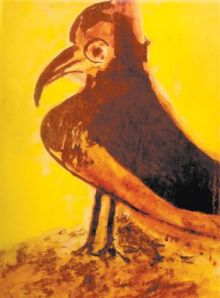The first non-European Nobel Prize winner, author of Indian and Bangladeshi national anthems, talented poet, traveler, and humanist Rabindranath Tagore discovered the world of fine arts when he was almost 70. The next 12 years he devoted to painting and graphic art, creating about 2,000 works. “The dawn of my life was filled with songs, so let the sunset be filled with colors,” said Tagore once.
It should be noted that Tagore never studied painting, he created his works as he thought he should, as his soul told him to. His contemporaries recollected that Tagore painted fast, confidently, with inspiration, and without editing finished paintings. Those pieces were created by impulse. This exact style of work let him build up a very rich art heritage in a short time. “He started painting, but he never learned how to do it. He attended four different schools, but he hated school and never graduated from a single one. Nevertheless, he founded two universities, won the Nobel Prize, and talked to Einstein... This person was a miracle!” told Mridula Ghosh, head of Eastern European Develompent Institute, Ph.D. in History and human rights activist to The Day during the inauguration ceremony of a literature and art project “Where a soul lives without fear...” which was dedicated to the 150th anniversary of Tagore’s birthday.
As Tagore explained once, his very own literature works made him give painting a try. Once he noticed that subconsciously he was making crossed-out passages in his manuscripts into wonderful ornaments. “I gave in to the charms of lines,” he said later. Tagore’s outstanding talent and artistic style inspired many generations of Indian artists, who followed their idol in their own creations. “He didn’t know how to paint and never studied it, but he painted in such a way that he started to inspire other artists, and even created a whole new style in our art,” Ghosh explains.
Some art critics draw analogies between his paintings and his poetic creations, which are full of incredible, delicate, sometimes folklore images. Natural colors, flexible lines, movement and stillness are combined in his works. Tagore liked to paint people’s portraits, and portray birds on canvas. “An artist is Nature’s lover. That’s why he is both Nature’s slave and master,” he often used to say.
Tagore became fond of painting when he was a golden ager, and very soon he unraveled as a talented and outstanding artist. In 1930 at the Pigalle Gallery in Paris his debut exhibit took place. It caused enormous stir not only in France but in India as well. It became a surprise for Indians that their poet and philosopher should have turned out to be a talented painter too. At that time Tagore’s paintings were bought up in no time and at a considerable price. After that his exhibits took place in different cities and countries, and all of them were destined to be a success. The author sold all the paintings and copyrights to raise money for a university he had founded.
Nowadays few of Tagore’s paintings can be seen in museums, most of them are kept in private collections. Collectors still show genuine interest in his canvases. The philosopher’s works became a real sensation at the London Sotheby’s auction in 2010. A collection that was made of 12 paintings by Tagore was sold for 2.2 million dollars, which was many times the sum predicted on the eve of the auction. This case was another proof of the fact that genuine, sincere and distinctive, luminous and harmonious art is always in demand.
Ukrainians have an opportunity to appreciate the talent of Tagore as an artist from near. An exhibit of reproductions of paintings, drawings, manuscripts, and photographs by Tagore, dedicated to his 150th anniversary, will take place at the Bohdan and Varvara Khanenko National Art Museum. It will remain open till October 9. Overall, about 65 of his works will be presented there. All of them are worth seeing, because these works are reflecting the soul of a genius, a person who propagandized tolerance, kindness, and love, who experienced a lot of grief and happines in his lifetime, who saw a lot of different countries and people. “Tagore is a humanist that could see the best in each and every person and culture,” underlines Ghosh. And this fact was reflected in his paintings.
“I don’t want to put walls around my house or blind my windows. I want the spirit of the culture of different countries to flow around as freely as possible, I just don’t want it to knock me off my feet,” said Tagore once. Today the spirit of Indian culture flutters around the rooms of the Khanenko Museum.









